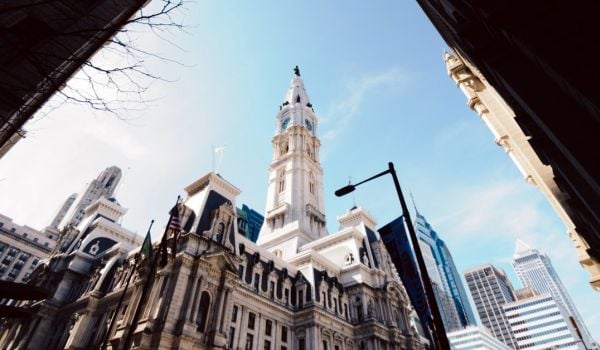Seven years ago, Matthew Mylet and the commercial lending team at Beneficial State Bank’s Portland office fielded a highly unusual loan inquiry. A local real estate trust needed a loan to buy a rather nondescript commercial retail and office complex along 122nd Ave. SE, in the far eastern reaches of the city. The trust had $430,000 in hand from other sources, but still needed $770,000 from the bank.
So far, all that’s pretty normal. For better or worse, trusts own a lot of real estate across the country these days. Low-slung retail and office complexes are a dime a dozen in Portland, as in many cities. Any commercial real estate broker worth their salt should be able to keep it fully rented out easily in a metropolitan area growing by an estimated 30,000 additional residents a year at the time.
What made this loan inquiry so unusual is that the owners of this particular trust, the East Portland Community Investment Trust, would come exclusively from the four zip codes nearest this property — primarily working class residents of color who had been displaced from other parts of the city or who had migrated here from other places. In a nutshell, the whole project is a living experiment in community engagement and wealth-building derived from commercial real estate ownership.
Most banks would balk at such a project. What does the average person know about owning a retail and office complex? How can a collection of primarily working class residents of color truly be trusted to repay this loan, even if they have support from a globally respected nonprofit? What the heck is a “community investment trust?” These are just some of the many questions any bank has to investigate when considering a loan like this one, producing an internal memo that can be 30 or more pages to justify making the loan. The more sophisticated the loan, the more layers of staff review required.
Mylet and his team ultimately did make that loan, and it was repaid back in 2017. They hope to make more loans like it, and to make them more frequently. And the possibility of doing so just went up thanks to a massive new investment in the bank by none other than the U.S. Treasury. Through a $218 million investment, the federal government has now become the bank’s largest shareholder.
Beneficial State is one of around 100 banks and more than 80 credit unions across the country that are receiving such an investment this year under the Emergency Capital Investment Program, or ECIP for short. Congress created ECIP to help with long-term economic recovery from the COVID-19 pandemic in historically marginalized communities.
“This isn’t grant money to give away, this is an investment in our business model to scale and reach more people than we have been,” says Beneficial State Bank CEO Randell Leach. “We know what the need is in our communities, it’s substantial, and it’s much bigger even than this. So this is a really good move, it’s an amplification of a solution. But it’s not the entire solution.”
The idea of the public sector partially or even fully owning banks may seem anathema today, after decades of private-sector driven policy that started during the Reagan Era and continued under presidents of both parties. But it’s actually how banking first took root in the United States.
After the ratification of the Constitution took away the power of states to tax imports and exports, one of the main ways states sought to generate revenue was through dividends from partial or even total ownership of banks. In the earliest days of the new republic, private bank investors needed approval directly from state legislatures to obtain bank charters, and often part of the agreement was the state would take an ownership stake in a new bank. Taxes on bank shareholdings were another popular revenue source: From 1836 -1840, 82% of Massachusetts state revenue came from banking-related sources, according to one study published in the Journal of Economic History. And there was usually an explicit or at least implicit deal struck, whereby the states chartering and investing in banks would expect those banks to help achieve public goals through financing construction of infrastructure, housing and industrial areas, in addition to earning profits for shareholders.
But over time, the public sector’s purview over banks, as shareholders or as chartering entities, has faded away into an afterthought. Banking industry lobbyists, not to mention economics departments and a lot of business journalism, have slowly but surely chipped away at the notion that the public should have any power over, let alone ownership of, banks. For many decades, only one state-owned bank survived, the 103-year-old Bank of North Dakota. It was joined in 2016 by the Territorial Bank of American Samoa.
ECIP hearkens back to that older tradition of the public sector taking an ownership stake in the banking system. But it’s not for just any bank — to be eligible for the program, in addition to being federally insured depositories, each bank, bank holding company or credit union must be either a Minority-Depository Institution or a federally-certified Community Development Financial Institution.
The U.S. Treasury ultimately received 204 ECIP applications, and in December 2021 announced 101 banks and 86 credit unions had their applications approved. The Department of the Treasury says it evaluated applications based on each institution’s financial health, its past track record of reaching the targeted communities and its plan for how it would grow as a result of the investment. ECIP recipients are located in 160 municipalities across the country, from the largest to some of the very smallest. The exact amount of each investment isn’t public until the investment agreements with each institution are finalized.
To understand how these investments might allow a bank like Beneficial State to make more loans like the one it made to the East Portland Community Investment Trust, start by imagining the full range of loan inquiries that come into the bank in any given period of time. Beneficial State is pretty diversified in its lending, including loans for multifamily housing, commercial real estate, small businesses, car loans and a growing volume of credit cards.
Some of those loan inquiries can get to approval quicker than others, even for a bank like Beneficial State that focuses on serving low-to-moderate income borrowers. Others take more time, especially commercial loans where there are a lot more factors to consider. This longer process is known as manual or custom underwriting.
“Every bank has its own underwriting metrics and commercial lending is often ‘custom’ in nature,” Mylet says. “Some common underwriting metrics include revenue trends, historic profitability, balance sheet position, value of collateral, financial strength of guarantors, length of time in business, experience of owners or managers, industry dynamics, and competitive position. In practice it’s rare to run across a business or organization that checks every box perfectly. If an applicant is weak in one area, they may be able to make up for it in another.”
Every bank wants to do both kinds of loans — usually a high volume of easy-to-underwrite smaller loans that cost relatively little time and effort to approve, and a smaller number of the larger, manually or custom underwritten loans that take more time but provide relatively more profit per loan.
Big banks catch a lot of flak for seeming like they only approve large volumes of home mortgages or small business loans that get past their algorithmic approval processes — algorithms that often perpetuate structural racism in the process. But the big banks do manually underwrite many loans; they just reserve these resources primarily for the largest loans to corporations or for billion-dollar projects that provide them the most bang for their shareholder dollars.
Growth allows Beneficial State Bank to manually underwrite more of the loans it is interested in spending those resources making. More income from a larger loan portfolio allows Mylet to bring more commercial lenders on staff at his Portland office, and his colleagues across the Oakland-based bank’s footprint up and down the West Coast can do the same for theirs. More commercial lenders also means more capacity to build relationships with potential borrowers on the commercial side, relationships that the bank at its current size might not have enough staff time to cultivate.
Usually to invest in more staff as well as technology to support growth, a bank has to ask private shareholders to invest more dollars upfront in exchange for more profits later. But that won’t be necessary for Beneficial State, thanks to the ECIP investment. The bank projects that the ECIP investment of $218 million will allow it to grow from $1.5 billion in assets today to at least $4 billion within ten years.
“We’re not going to grow to $4 billion overnight,” Leach says. “We’re focusing now on increasing capacity, both with new technology as well as staffing. Another big step is looking at opportunities for new product lines, some sectors or markets we can better serve, maybe expansion of capabilities, potentially acquiring other banks.”
The ECIP investment terms are also structured to encourage growth — after a two-year grace period, the dividend rate Beneficial State will pay to the U.S. Treasury will be lower the more lending it does to the targeted low-income or minority borrowers, ranging from 2% to as low as 0.5% per year.
One big risk is that ECIP investments push the recipient banks or credit unions to grow too fast, resulting in loan products that end up being predatory for the sake of growth. Part of the onus to prevent that lies with regulatory agencies like the Consumer Financial Protection Bureau to effectively guard against that on a nationwide scope.
Each ECIP recipient’s ownership structure also bears some responsibility to ensure responsible, non-predatory growth — while also trying to get more creative about meeting more unmet credit needs. For credit unions, of course, that’s their own members. A number of ECIP recipients are Black-owned, Latino-owned, Asian-owned or Indigenous-owned banks. Beneficial State is an oddball – other than the U.S. Treasury, its largest shareholder is the nonprofit Beneficial State Foundation, established by the wealthy couple Kat Taylor and Tom Steyer. The couple does not receive any profits from the bank, any profits they would receive stay with the foundation instead.
“We’re still a bank, we have to focus on safety and soundness, so we need to maintain diversification across our portfolio,” Leach says. “But the way we go about that is different since we’re not trying to maximize financial return. So our starting point is vastly different.”

Oscar is Next City's senior economic justice correspondent. He previously served as Next City’s editor from 2018-2019, and was a Next City Equitable Cities Fellow from 2015-2016. Since 2011, Oscar has covered community development finance, community banking, impact investing, economic development, housing and more for media outlets such as Shelterforce, B Magazine, Impact Alpha and Fast Company.
Follow Oscar .(JavaScript must be enabled to view this email address)











